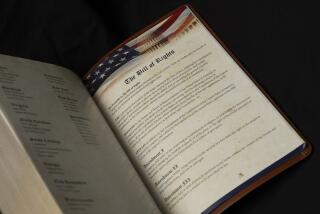Sacred but also familiar
- Share via
A few years ago, on the theory that many readers of the Bible don’t have any idea what a manger is, the American Bible Society replaced the word in a new edition with the phrase “feed box.”
The change never caught on. All you have to do is sing a few bars of “Away in a Feed Box” to understand why the Virgin Mary still places baby Jesus in a manger in most versions of the Bible sold in the United States today.
But the broader effort by the American Bible Society to find language meaningful to 21st century readers certainly has caught on. It is part of a trend in Bible publishing to make the book accessible to people intimidated by the “thees” and “thous” and other antiquated language of the 17th century King James Version.
“We’re always looking for better ways to engage people in the Bible,” said Paul Caminiti, a vice president for Zondervan, a Bible-publishing giant in Michigan. “Plain-text Bibles are well over 1,000 pages. We’re talking about 66 different books of the Bible, and a book that was written to a culture that is 2,000 to 4,000 years old. It can be challenging for people to jump into.”
The options include:
* “The Bible Experience,” an audio version available as a CD or MP3, which first went on sale this fall featuring 250 African American entertainers, including actor Blair Underwood reading as Jesus.
* “The Story,” a 464-page book first sold last year, which shuns standard chapter-and-verse breakdowns for a narrative form.
* The “New Living Translation,” first published in 1996. It is the fourth-bestselling Bible translation at Protestant bookstores in the United States, and it is written at a sixth-grade level, according to CBA (formerly the Christian Booksellers Assn.).
* The New International Version, first published in 1978, is the most popular Bible sold at Protestant bookstores in the United States and is written at an eighth-grade level.
At bookstores, the translations have led to an alphabet soup of initials: KJV, NLT and NIV, to name just a few.
The King James Version, renowned for centuries for its majestic, rhythmic prose and poetry that can entrance those it doesn’t befuddle, was long the bestselling English version. It’s still the second-bestselling Bible in the country, according to CBA. The New King James Version, considered slightly easier to read, was published in 1982 and sells third-best in the country at Protestant bookstores.
Bible translations usually involve dozens of scholars who know their quest for readability will fail if English readers think a translation strays too far from the King James Version. Some scholars translate every word literally from ancient sources, while others go “thought for thought,” concerned more that broader passages are understood.
Robert Hodgson, an American Bible Society scholar, said that even the broadly done translations are valuable.
“Christianity is a translated religion,” he said. “From the times of Jesus onward, Christians have depended on translation to spread the word around the world. Jesus spoke in Aramaic, but the Gospel writers wrote those words down in Greek and within [100 years] that was translated into Latin.”
“The thing to remember is, the original Bible authors and writers were writing to be understood. They were not trying to write in obscure or archaic or even difficult language,” Hodgson said.
More to Read
Sign up for our Book Club newsletter
Get the latest news, events and more from the Los Angeles Times Book Club, and help us get L.A. reading and talking.
You may occasionally receive promotional content from the Los Angeles Times.






